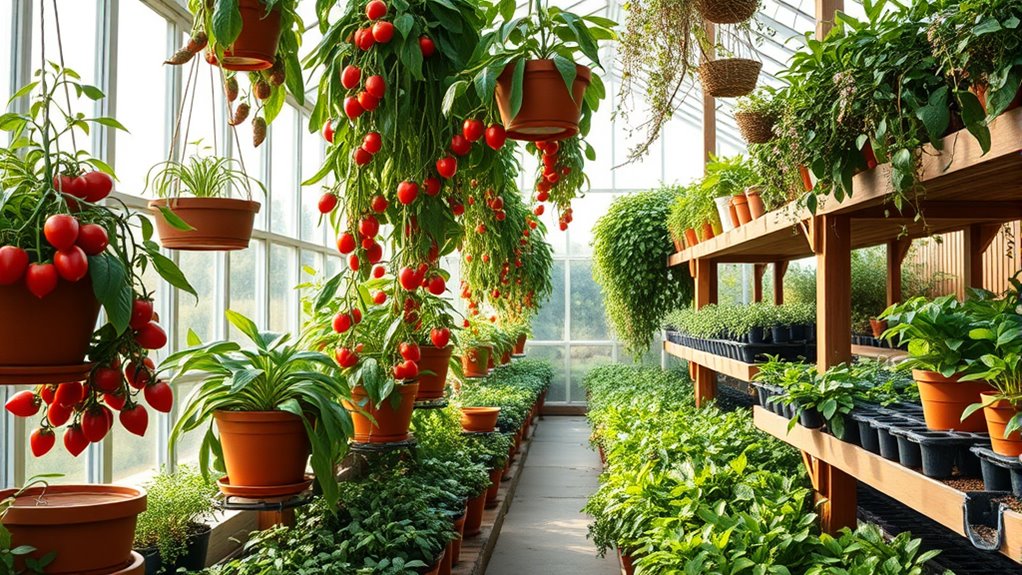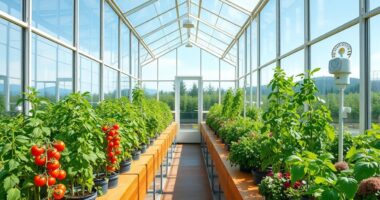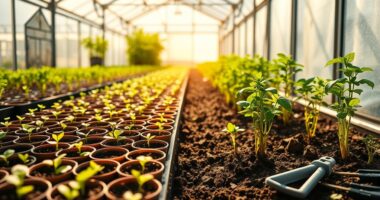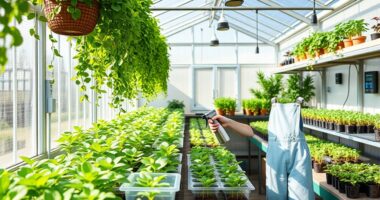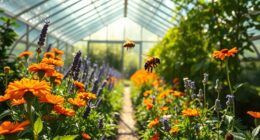In your greenhouse, you can grow a variety of plants like tomatoes, peppers, and eggplants, which thrive with consistent warmth and humidity. Herbs such as basil, mint, and parsley flourish indoors, while flowers like orchids and begonias add color and vibrancy. Vertical gardening techniques help maximize space for leafy greens, strawberries, and herbs, making your greenhouse productive and beautiful year-round. Keep exploring to discover more tips for healthy, abundant growth.
Key Takeaways
- Choose temperature-tolerant vegetables like tomatoes, peppers, and eggplants for consistent greenhouse warmth.
- Grow herbs such as basil, mint, and parsley for easy maintenance and year-round harvest.
- Cultivate flowering plants like orchids, begonias, and ferns to add color and vibrancy indoors.
- Select plants that thrive in high humidity, including certain tropical foliage and flowering species.
- Incorporate vertical gardening to maximize space for densely planted vegetables and decorative plants.
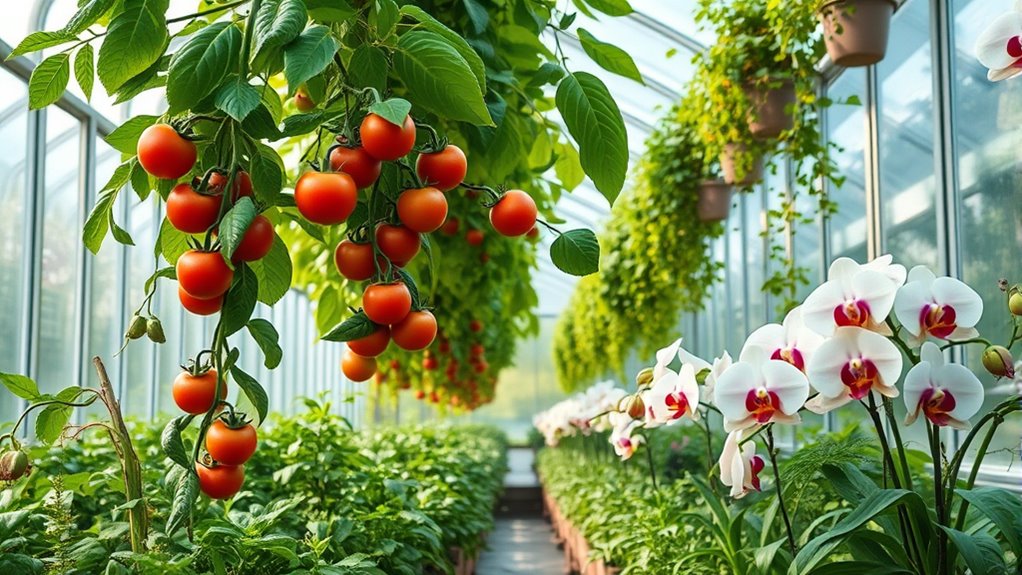
A greenhouse provides an ideal environment for growing a wide variety of plants year-round. It allows you to control temperature, humidity, and light, giving you the perfect conditions to nurture everything from vegetables to flowering plants. If you’re looking to maximize space and productivity, consider incorporating vertical gardening techniques. By stacking plants upward, you can make efficient use of limited floor space, especially in smaller greenhouses. Vertical gardens are perfect for herbs, strawberries, or even leafy greens, making it easier to access and maintain your crops. Plus, they can add an attractive visual element to your greenhouse, creating a lush, layered environment that promotes healthy growth.
Maximize your greenhouse space with vertical gardening for lush, easy-to-maintain crops and vibrant visual appeal.
When practicing vertical gardening, pay attention to pest management. The close proximity of plants in vertical setups can sometimes facilitate pest spread, so it’s essential to stay vigilant. Regularly inspect your plants for signs of pests like aphids, whiteflies, or spider mites, and address issues early before they become widespread. Use integrated pest management strategies that combine biological controls, such as beneficial insects, with organic treatments to keep pests in check without harming your plants or the environment. Proper air circulation is also vital; it helps prevent many common pest problems and reduces the likelihood of fungal diseases. Ensure your vertical garden has enough space around it for airflow, and avoid overcrowding. Additionally, maintaining optimal humidity levels can greatly influence plant health and pest control effectiveness. Controlling humidity can also help prevent issues like plant diseases, which are common in greenhouse environments.
In addition to vertical gardening, many plants thrive in a greenhouse environment because of the controlled conditions. Tomatoes, peppers, and eggplants are popular choices for greenhouse cultivation because they love consistent warmth and humidity. These plants tend to produce higher yields and better quality fruit when grown under prime conditions. Herbs like basil, mint, and parsley also flourish indoors, providing fresh flavors for your kitchen. Flowers such as orchids, begonias, and ferns can add color and variety, turning your greenhouse into a vibrant oasis.
To guarantee your plants flourish, you need to stay attentive to their specific needs. Maintain proper watering schedules, monitor humidity levels, and provide adequate lighting. Regular pruning and cleaning help prevent disease and promote vigorous growth. When integrating vertical gardening, remember to support your plants properly and keep pest management practices in mind to protect your investment. With the right approach, your greenhouse can become a year-round source of fresh produce, beautiful flowers, and a relaxing space to enjoy nature’s bounty.
Frequently Asked Questions
How Do I Control Pests in My Greenhouse Effectively?
To control pests effectively, you should implement integrated pest management (IPM) strategies. Start by regularly inspecting your greenhouse and removing infested plants. Use biological control, like introducing beneficial insects such as ladybugs or predatory mites, to naturally reduce pest populations. Keep your greenhouse clean and maintain proper humidity and airflow. Combining these methods helps you manage pests sustainably, protecting your plants without relying heavily on chemicals.
What Are the Best Soil Types for Greenhouse Plants?
Think of your greenhouse soil as the foundation of a thriving garden. The best soil types offer perfect drainage, preventing waterlogging, and maintain a balanced nutrient profile to fuel plant growth. Loamy soil, a harmonious blend of sand, silt, and clay, often hits the sweet spot. It guarantees roots breathe freely and receive essential nutrients, turning your greenhouse into a lush oasis where plants flourish effortlessly.
How Can I Extend My Growing Season Indoors?
To extend your growing season indoors, focus on season extension techniques like using grow lights to supplement natural light and maintaining ideal temperatures. You should also consider using thermostats and humidifiers to create a stable environment. Proper indoor lighting is essential for photosynthesis, especially during shorter days. By controlling these factors, you can successfully grow plants year-round, maximizing your indoor gardening potential and enjoying fresh produce or flowers well beyond the typical season.
What Are Common Mistakes Beginners Make in Greenhouse Gardening?
Imagine your greenhouse as a delicate symphony, where every note matters. Beginners often make mistakes like neglecting watering issues or misjudging lighting problems, which disrupt the harmony. You might overwater or underwater, or fail to provide enough light, causing plants to struggle. Pay close attention to your plants’ needs, ensuring proper watering and ideal lighting. This balance helps your greenhouse flourish, turning it into a thriving, vibrant sanctuary.
How Do I Maintain Optimal Humidity Levels in a Greenhouse?
You can maintain essential humidity levels by managing your humidifier effectively and using misting systems. Regular humidifier management ensures the air isn’t too dry or too damp, which is vital for healthy plants. Incorporate misting systems to increase humidity during dry periods and guarantee proper circulation to prevent mold. Keep a hygrometer nearby to monitor levels, adjusting your equipment as needed for consistent, perfect humidity in your greenhouse.
Conclusion
Now that you’ve discovered some of the best plants to grow in your greenhouse, imagine the possibilities waiting to unfold. Will your next harvest be a vibrant burst of color or a lush, fragrant bounty? The right choices can transform your space into a thriving sanctuary. But there’s more to explore—secret tips and rare varieties that could elevate your greenhouse game even further. Are you ready to unseal these green secrets and take your gardening to the next level?
